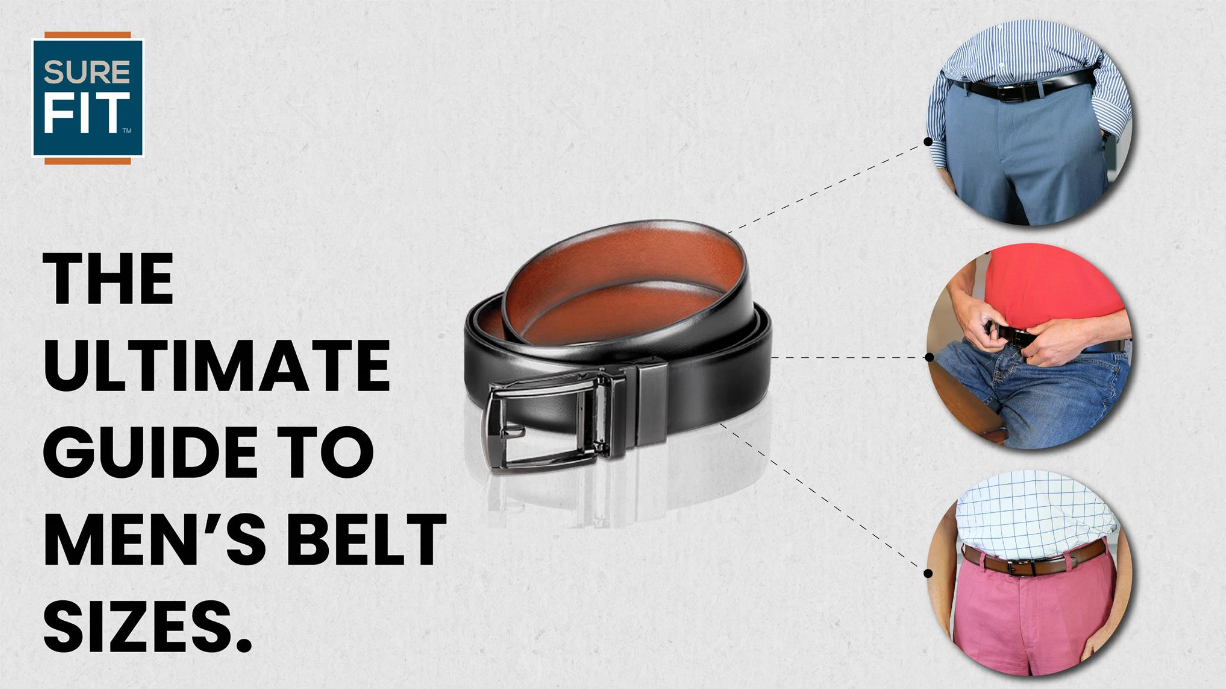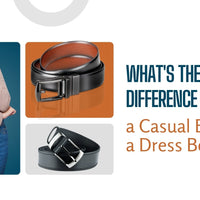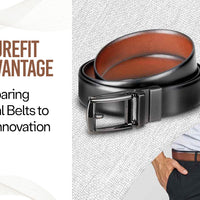Summary
- Measuring your waist directly ensures the most accurate belt size for a comfortable, stylish fit.
- Adding 2-3 inches to your pant size provides a quick estimate for selecting the right belt.
- Checking Size charts helps you choose the correct belt size with confidence and ease.
- Opting for adjustable belts, such as SureFit, eliminates issues with overhang or incorrect sizing problems.
A belt does so much more than hold your pants in place; it’s a key piece that ties your outfit together, boosts your confidence, and ensures all-day comfort. A poorly fitted belt can throw off your entire look, leaving you tugging at your waistband or dealing with unsightly overhang.
However, the wrong size might dig into your skin during long days or fail to complement your style, whether you’re dressing for a boardroom or a casual weekend. With so many belts on the market, finding one that fits perfectly can feel daunting, but innovative designs make it easier than ever.
This guide breaks down everything you need to know to find your ideal belt size and make wardrobe mishaps a thing of the past.
Why Belt Size Matters
The Right Fit for Comfort
Imagine slipping into a belt that fits just right—no digging in, no awkward bulges. A well-fitted belt keeps your pants in place and feels comfortable throughout the day. An ill-fitting belt can be a source of irritation, causing you to constantly adjust it or, worse, leading to embarrassing situations like your pants slipping down.
A belt that's too tight can leave you feeling constricted, while one that's too loose might lead to a wardrobe malfunction (and we all know how embarrassing that can be!). Comfort isn't just about feeling good; it's about looking good too. A belt that fits well allows you to move freely, whether sitting, standing, or walking.
Style and Presentation
A belt isn't just a functional accessory and a style statement. Wearing the wrong size can throw off your entire look. A belt that is too small can disrupt the clean lines of your outfit, while an oversized belt can overwhelm your frame.
A sleek, tailored belt can enhance your silhouette, while a bulky one can make you appear less polished. When you choose the right size, you enhance your comfort and overall appearance, making you look more put-together and confident. Think of your belt as the cherry on top of your outfit—it should enhance, not detract. This means considering the color and material and how the belt's width and style play into your overall ensemble.
How to Measure Your Belt Size

Tools You'll Need
Before you start measuring, gather a few tools: a flexible measuring tape, a pen, and a piece of paper. If you don't have a measuring tape handy, you can use a piece of string and measure it against a ruler later. The key is to have something that will give you an accurate measurement. Knowing your waist size will save you many headaches when shopping for belts, so measuring correctly is essential. Having a friend assist you can also help ensure accuracy, especially if you're using a measuring tape.
Finding your ideal belt size doesn’t have to be complicated. Here are three reliable methods to get it right, tailored to work seamlessly with an adjustable design.
Method 1: Using an Existing Belt
If you have a belt that fits well, this is the easiest way to determine your size. Lay it flat on a surface and use a tape measure to measure from the buckle’s base (where it meets the leather) to the hole you use most often. This length, in inches, is your belt size. Also, always make sure to note the measurement and check the size chart to pick the closest range, as the adjustable buckle fine-tunes the fit.
Method 2: Waist Measurement
For the most accurate fit, measure your waist directly. Wrap a flexible tape measure around your natural waistline where you wear your pants, typically just above the hips. Keep it snug but not tight, and note the measurement in inches. Add 2-3 inches for comfort; this method ensures your belt feels just right, whether you’re sitting or standing.
Method 3: Pant Size Conversion
If you’re in a rush, your pant size can give a quick estimate. Take your pant waist size (e.g., 34 inches) and add 2-3 inches to get your belt size (e.g., 36-37 inches). Be cautious, as pant sizes vary across brands.
Understanding Belt Sizes
Size Chart Overview
Most belts are sized in even numbers. Here's a quick reference guide:
- Small (S): 30-32 inches
- Medium (M): 34-36 inches
- Large (L): 38-40 inches
- Extra Large (XL): 42-44 inches
This chart can vary by brand, so always check the specific sizing chart provided by the manufacturer. For example, some brands might even offer half sizes or custom options for those who need a precise fit. If you fall between sizes, choosing the larger size is typically recommended for comfort.
Different Sizing Systems
Different brands might have different sizing systems. For instance, some might offer a one-size-fits-all approach, while others might have specific measurements. It's essential to refer to the brand's sizing guide before purchasing.
Final Tips
Getting your belt size right is key to looking sharp and feeling comfortable. Whether you measure an existing belt, your waist, or use your pant size, always cross-check the size chart for accuracy. Regularly check your belt for wear, especially if your waist size changes due to weight fluctuations. For the best buy, you can also check SureFit Belt, which helps in making sizing effortless with its micro-adjustable, hole-free design that takes the stress out of sizing.
Choose one that adapts to you. Explore SureFit Belt for belts that combine style, comfort, and precision. Don’t settle for a belt that’s too tight or leaves excess overhang.
FAQs
What if I’m between sizes?
If you’re between sizes, always size up for comfort. SureFit’s adjustable buckle allows fine-tuning for a perfect fit. Sizing up when between sizes ensures comfort with SureFit’s micro-adjustable, hole-free belt design.
Can I alter a belt?
Avoid DIY alterations, as cutting can damage the belt. SureFit’s adjustable style eliminates the need for modifications. Choosing SureFit’s adjustable belt prevents the need for risky DIY alterations to fit.
Which belt should I wear with suits?
Slim leather belts, like SureFit’s sleek, reversible design, pair perfectly with formalwear for a polished look. SureFit’s slim, reversible leather belt complements suits for a sophisticated, professional appearance.
How long do belts last?
With proper care, a quality belt like SureFit can last years. Clean with leather conditioner and store properly. Caring for your SureFit Belt with leather conditioner ensures durability for years of use.
Read More Articles:
















